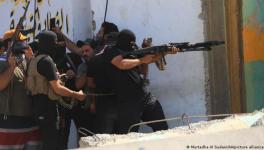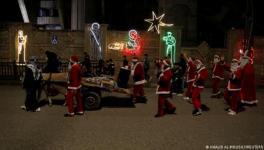Come and See the Iraq George Bush 'Liberated'
First Falluja, then Mosul, and now Tikrit. The pace at which the al Qaeda-inspired militant group Islamic State of Iraq and Greater Syria (ISIS) is taking control of Iraqi cities is stunning. The state the Americans built over the years after crushing Saddam Hussein’s Iraq is crumbling away.
ISIS’ seizure of Mosul, Iraq’s second largest city on June 10, is by far the greatest victory of the militant group that wants to establish an Islamic emirate straddling Iraq and Syria. They have captured the main military base in Mosul, released hundreds of prisoners, and seized up to $480 million from the city's banks. They are now about 100 km south of Baghdad, and have vowed to march towards the Iraqi capital. The Institute for the Study of War reports that ISIS attacked Mosul with 150 vehicles armed with mounted crew-served weapons and between 500 and 800 troops. It says Iraqi troops just fled when they came under heavy attacks.
ISIS has its roots to the al-Qaeda of Iraq, which thrived on the bloody sectarian civil war in Iraq erupted after the 2003 US invasion. The fall of Saddam Hussein and the subsequent dismantling of the Iraqi state by the Americans have created a huge power vacuum in Iraq which multiple forces, including hardline Jihadis tried to fill in. With the fall of Saddam, a great wall that stopped the surge of Jihadi forces for decades also fell apart. The rise of Shias to political power in Iraq, a country ruled by minority Sunnis for centuries, reopened the sectarian faultlines, which plunged Iraq into a humanitarian catastrophe.

Image Courtesy: en.wikipedia.org
Things seemed to have calmed down in 2009 after the Americans beefed up their military presence in Iraq, recruited local Sunnis to take on Sunni militants and won the support of Iraq’s tallest Shia leader Ayatollah al Sistani. Civilian causalities came down to 4,110 in 2010 from 30,000 in 2006. But the latest incidents in Iraq shows that that lull in violence was only the calm before the storm. George Bush went to attack Iraq well before he could stabilise Afghanistan. In effect, he destroyed both nations and made the lives of their people horrible. President Barack Obama and his European and Gulf allies went to overthrow Syrian President Bashar al Assad well before he could stabilise Iraq. In effect, Obama and Co offered a new battlefield and a cause around which r Jihadis to regroups themselves.
Abu Bakr al Baghdadi, the self-proclaimed leader of the ISIS, was among the first Jihadis who seized the opportunity. He regrouped the remnants of the Iraqi Qaeda in the wake of the Syrian crisis. It was easy for him to recruit militants from among Sunnis in Iraq who were not only left out of the political process under Nouri al-Maliki's sectarian Shia-dominated government in Baghdad but were also persecuted.
He sent militants across the border to Syria to fight President Bashar al Assad, whose Alawite-dominated government is fighting a sectarian Sunni opposition in a protracted civil war. The al-Nusra Front, the Syrian wing of the al Qaeda, had joined hands with Baghdadi's troops to fight Assad. They emerged as the most powerful extremist group in the Syrian theatre. The Gulf kingdoms, especially the Saudis and the Kuwaitis, helped them. The Saudi royal family desperately wanted Assad gone (for geopolitical and ideological reasons), and therefore, was ready to back anybody to bleed Syria. The West’s attempts to weaken the Assad regime helped ISIS and its co-Jihadis establish a strong presence in Eastern Syria, which led them capture the city of Raqqa in December 2003.
Baghdadi had wider plans. He stepped up attacks in Iraq, especially against Shias, at the same time his men were fighting in Syria. Civilian killings in Iraq more than doubled to 9,500 in 2013, from 4,500 the year before. In the current year, 6600 deaths are already reported (excluding the recent killings of Iraqi troops after ISIS captured Mosul). The border between Iraq and Syria is effectively erased. ISIS controls some parts of eastern Syria. In Iraq, they took Falluja and Ramadi and parts of the Anbar province early this year. With the fall of Mosul, their influence in the Nineveh province became stronger. Baghdad may already be feeling the heat.
As Vijay Prashad, author of The Poorer Nations, said, the people of Iraq and Syria are “prisoners of a burning prison”. This writer is not a fan of Saddam Hussein. But given the slaughtering, anarchy and madness Iraq is witnessing today, ordinary Iraqis must be missing their former President, who, despite presiding over a ruthless regime, had modernised Iraqi society and economy and kept the religious extremists always at bay.
George W Bush’s invasion dismantled that Iraq and the set the stage for building the current slaughterhouse. Bush must be singing aloud now, 'But you 're an animal, baby it's in your nature. Just let me liberate you (again)'.
Stanly Johny is a journalist. He can be contacted at stanly.mambilly@gmail.com
Disclaimer: The views expressed here are the author's personal views, and do not necessarily represent the views of Newsclick
Get the latest reports & analysis with people's perspective on Protests, movements & deep analytical videos, discussions of the current affairs in your Telegram app. Subscribe to NewsClick's Telegram channel & get Real-Time updates on stories, as they get published on our website.
























